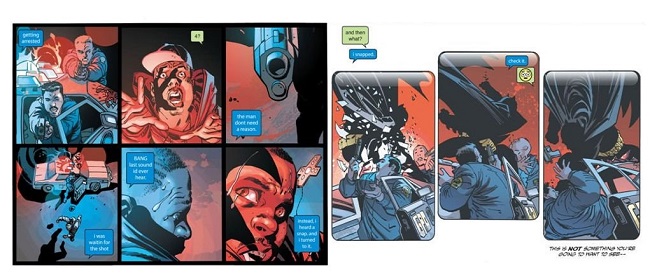
On November 24, 2015, Chicago police officer Jason Van Dyke was charged with the first-degree murder of an African American teenager. The following day DC Comics released the first issue of Dark Knight III: The Master Race, the highly anticipated comic from the legendary Frank Miller, who brought us The Dark Knight Returns nearly three decades ago.
It’s here! Get DARK KNIGHT III: THE MASTER RACE #1 and see what everyone’s talking about: https://t.co/06Z8QS2aFN pic.twitter.com/PNbgymmvXY
— DC Comics (@DCComics) November 25, 2015
The comic opens with two officers pointing their guns at a man named Squid. “Getting arrested,” Squid texts a friend. When the friend asks why, he responds, “The man don’t need no reason.” As Squid runs thinking this is the end, he hears a snap, turns, and sees Batman taking down the crooked cops saving the young Gothamite from peril.
Batman saving a black man from police brutality (from Dark Knight III: The Master Race #1) pic.twitter.com/JzKmvp1fD1
— Mario Pabon (@restlessbit) November 29, 2015
Miller told Vulture:
“What I feel was misinterpreted most was that people thought I’d cast Batman as an anti-hero, when, in fact, I’d intended him as the purest of heroes. The idea was that he was, like Robin Hood, a character introduced in a time when the established order was wrong and had to be overturned. So he is, politically, a radical and a revolutionary out to overthrow a corrupt police state. It’s a very patriotic and loyal-to-the-law kind of story, but the established authorities were doing the wrong thing, so it took an outlaw to bring justice.”
Dark Knight opens with Batman saving a Black man from police. Our realities are bleeding onto our storytelling.https://t.co/IuRnD2UVQ9
— Javier✊Suárez (@javiercantdraw) November 30, 2015
The issue came two months after the publication of Batman 44, which featured a scene where a hooded black teenager is shot in the stomach by a police veteran after a fight in a bodega. Lead writer Scott Snyder admitted the scene was inspired by events in Ferguson, Missouri. Snyder told The Guardian:
“If we were going to do an issue that dealt with potent problems that people face in cities that are reflected fictitiously in Gotham, then we want to really put our money where our mouth was and explore something that’s extremely resonant right now, and, I think, tricky, murky waters.”

An analysis of the available FBI data shows that US police kill black people at disproportionate rates. The disparities appear to be even starker for unarmed suspects. Racial minorities made up about 37.4% of the general population and 46.6% of armed and unarmed victims, but they made up 62.7% of unarmed people killed by police.
This article (Dark Knight’s Batman Saves Black Man from Police Brutality) is a free and open source. You have permission to republish this article under a Creative Commons license with attribution to the author and AnonHQ.com.




